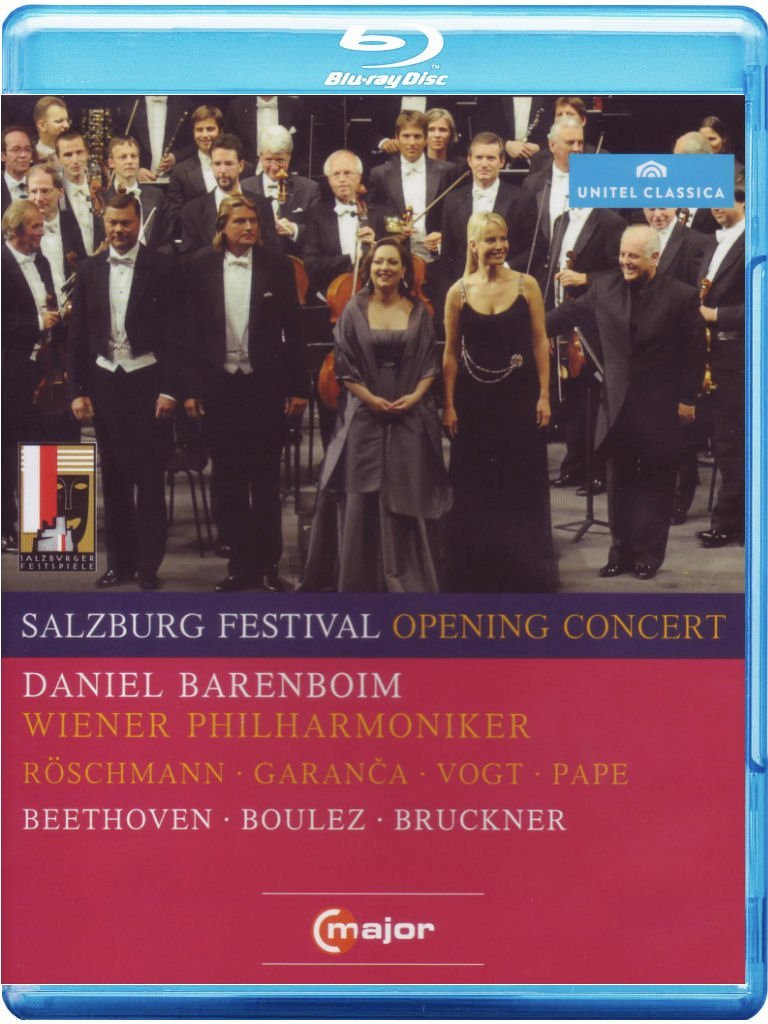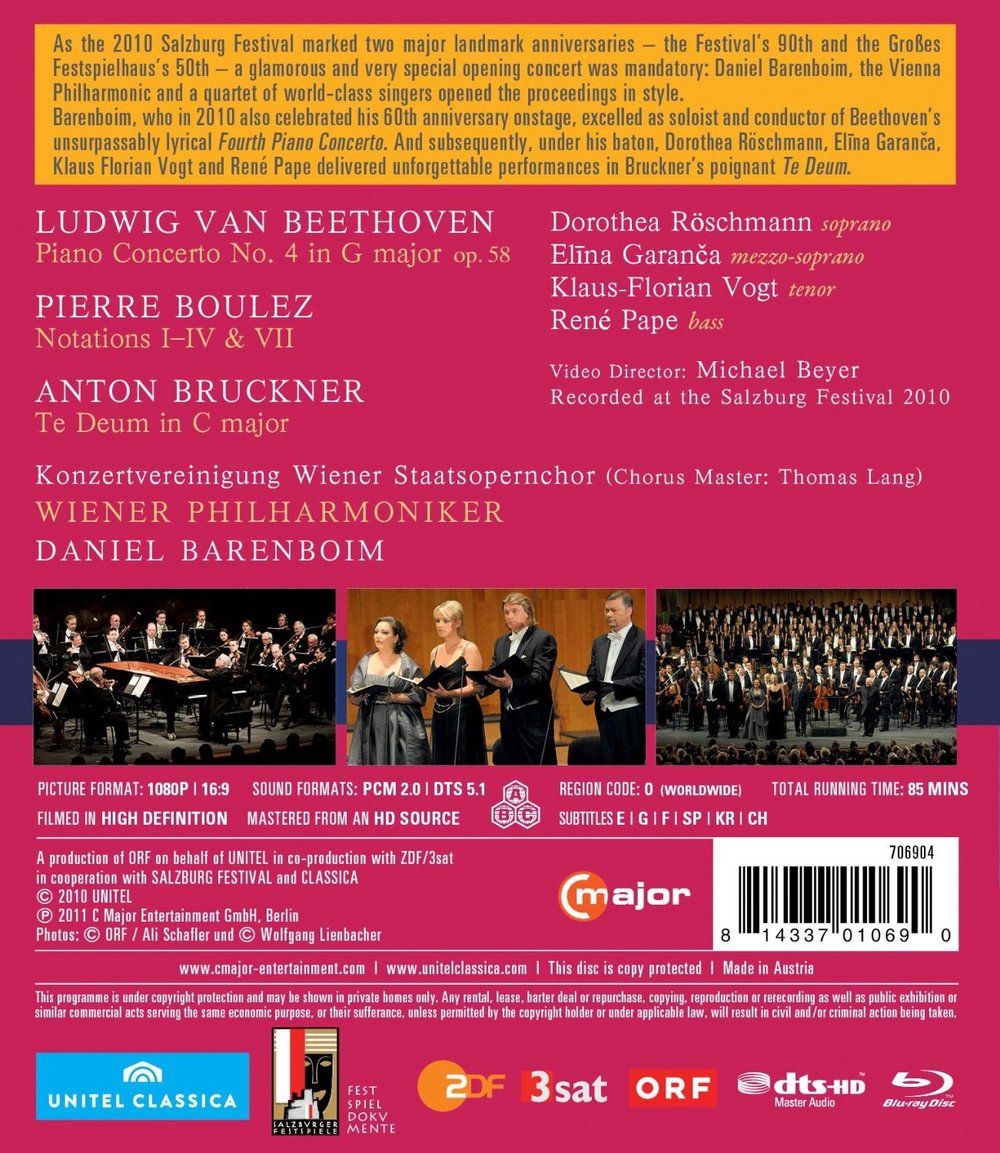

The 2010 Opening Concert for the Salzburg Festival consists of:
Beethoven Piano Concerto No. 4
Boulez Notations for Orchestra
Bruckner Te Deum
Daniel Barenboim conducts the Vienna Philharmonic Orchestra and is the piano soloist for the piano concerto. Soloists in the Te Deum are Dorothea Röschmann (soprano), Elīna Garanča (mezzo), Klaus Florian Vogt (tenor), and René Pape (bass). Directed for TV by Michael Beyer; Video Editor was Gernot Arendt; audio by Alfred Zavrel. Released 2011, disc has 5.0 dts-HD Master Audio sound. (See individual sections of review for grades of each piece.)
Let's start with general comments. PQ is excellent throughout. Although this doesn't purport to be an audiophile-level sound recording with 96kHz/24 bit sound-sampling, the dts-HD Master Audio sound beats CDs and DVDs. In the past we got quite a few HDVDs of ad hoc concerts performed to celebrate events. A lot of these titles are mediocre. But this is a serious program performed by a top orchestra augmented with much guest-artist glitter.
Beethoven Piano Concerto No. 4
We already have a recording of Barenboim playing and conducting the Beethoven Piano Concerto No. 4 at the Klavier-Festival Ruhr on the EuroArts label. But subject performance is even—n better. Here Barenboim plays with both the utmost in power and finesse. And the (larger) Vienna Philharmonic Orchestra provides sound with a tenderness and refinement that surpasses the work of Barenboim's own Staatskapelle.
That's the good news---now we get into the other kind. We have written extensively on this site about the characteristics of a good HDVD of a symphonic work. A good HDVD follows Huang's law: "Use the flexible power of the the high-def camera to get a pleasant (not hyperactive) mixture of shots of the whole orchestra, groups of sections, large sections, small sections, groups of sections and individuals, and solo players---depending on what forces the composer commits at various places in the score." In other words, give the viewer as much visual information as possible and only go in for close-ups when there's a specific reason.
You can't follow Huang's law in a DVD. The low resolution of the DVD camera makes it difficult or impossible to get a decent image of a whole symphonic orchestra. This pretty much forces the DVD director to make a movie by stringing together a long series of close-ups of "easy targets." We call this a "road runner race" in honor of the Road Runner cartoons. If you shoot a good DVD, it will be a bad HDVD. If you shoot a HDVD, it will not look good in DVD. The two products are mutually exclusive.
We felt joy when we saw the first image of the Weiner Philharmoniker on this disc: a beautiful, interesting whole-orchestra shot as the band warmed up. We could easily see all the sections and the PQ was excellent. Next came a side shot that showed Barenboim coming on the stage head on. This was exciting because this is the best way to get the conductor on stage without having motion artifacts from a panning camera. So the first two images in this show follow our principles for a good HDVD!
Once the concerto performance began, we expected to see a magnificent whole-orchestra shots right away. But no, instead, we saw close-ups. Alas, Beyer took this opportunity to make a gorgeous, memorable HDVD, pulled the handle, and flushed it down the DVD drain!
There is not a single 100% whole-orchestra view in this concerto. Instead, Beyer gives us the usual DVD fare. Barenboim's piano playing is chopped up into 136 fast cuts. In addition, there are 19 low-value shots of Barenboim as conductor peering up over the piano looking at the orchestra. Mixed in are 110 shots of tiny fragments of the orchestra, including 17 instrument-only shots.
So why did Beyer do this? The fault lies with the bosses. They told Beyer to make a DVD, which he did. Then the bosses tried to harvest more from the shoot by selling it also in a Blu-ray wrapper. The bosses are correct when they say the Blu-ray has a sharper picture than the DVD. But what they don't know or don't care about is that the best DVD ever made will be a poor HDVD. Grade: C
Boulez Notations for Orchestra
Listening to the Boulez Notations for Orchestra is like putting on an inner tube and going over a waterfall — we survived and it was exciting. Notations is modern music heading off in experimental directions. Barenboim uses a score (the only time we've seen him not work from memory) that looks like it might be the schematic plans for a factory complex. We counted about 117 musicians on the stage including a doubled percussion section. It's a challenge to take all this in; but that's OK, because it's short.
Once again, the video content for the 22-minute Notations is almost pure DVD. Faced with huge forces onstage and a chaotic score, the TV folks all but gave up on showing us anything other than the conductor, solos, small fragments of sections, and (26!) instrument-only shots. There are 4 brief part-orchestra shots with 90% of the players, but 2 of these were made while the orchestra was at rest between movements. There is only one 100% whole-orchestra view (49:21), which serves to prove that Beyer could have made a decent HDVD out of this had the stars been so aligned. Changing the subject, we got the impression that SQ for Notations was not as good as for the Beethoven Piano Concento No. 4. Notations was recorded in a different room and it's possible there were not enough mikes to go around. Grade: C
Bruckner Te Deum
T—The Bruckner Te Deum is a bracing, refreshing work that is also short. The four solo singers are a dream team, all of whom we know well from other HDVDs. In this Te Deum, the tenor takes the lead. You might wonder if Vogt, whose voice is sincere, sweet, and refined, would be overshadowed by the other glorious forces on stage. Well, he probably could not project his voice with the penetrating power of either of the ladies next to him. But he manages to be heard well enough and to blend in well with the quartet. The PQ remains great, and the SQ in this segment is also very nice.
The Te Deum is also troubled with too many DVD characteristics. But there are 4 fine whole-orchestra shots and 9 part-orchestra shots. We also liked the 33 views of members of the choir, all exceptionally beautiful even if too many of them showed only a few singers. So here we find only mild DVDitis and arrive at: Grade B
Here are two trailers for this Opening Concert:
OR
